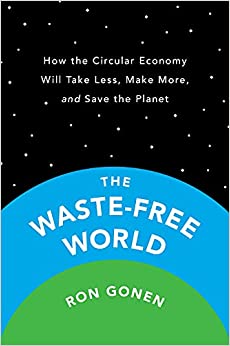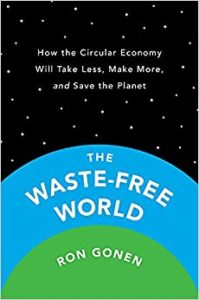By Stas Margaronis, RBTUS
Ron Gonen provides a primer for companies and people who want to support waste-free products and business strategies. His theme is that a “circular” economy can develop around products and strategies that utilize recycling. The growth of stores selling waste-free products is backed by the growing participation of companies and producers who are moving away from plastic. Products that cannot be recycled pose an environmental hazard when disposed of in landfills, in oceans or in the air.
Gonen, is the founder and CEO of Closed Loop Partners, a company focused on the support of a waste-free and a sustainable product economy. Previously, Gonen served as the deputy commissioner for sanitation, recycling and sustainability in New York City under former New York Mayor Michael Bloomberg.
The Negative Impacts of Production
Gonen cited John Kenneth Gailbraith’s ‘Affluent Society’ published in 1958. The book warned that the concept of production, or gross domestic product, as a measure of U.S. society’s well-being omits important measures of social and personal well-being. Gross domestic product (GDP) has its origins in an industrialization process that did not take into account creating inequality and negative environmental impacts. These environmental impacts are now having catastrophic effects on global climate and need to be factored.
A major culprit is the concept of planned obsolescence which is incorporated in everything from cars to smart phones creating waste in unnecessary mining, energy, resources and pollution. The result is a global glut of throw-away cars, phones and plastic causing massive garbage dumps on land and sea. Companies shift these costs to people through disposal fee at landfills plus environmental and health dangers such as contaminants that leak into the ground, air and water.
Another book that challenged the conventional wisdom of industrial production was Rachel Carson’s book ‘Silent Spring’. ‘Silent Spring’ is considered the book that started the global grassroots environmental movement. Published in 1962, the book focuses on the negative effects of chemical pesticides that were, at the time, a large part of U.S. agriculture. Rachel Carson and her work began initiating a shift in global environmental consciousness.
Polluters Attack Reformers
Gonen notes Carson was the subject of negative advertising by chemical companies producing pesticides who tried to create doubt about the truth of her work.
Gonen describes the development of negative corporate campaigning in resisting change. He describes the case of one company manufacturing Styrofoam that has slowed down efforts to ban the production of throwaway plastic used in packaging and for food and drink products.
In 2013, as New York City deputy commissioner for sanitation, Gonen proposed banning Styrofoam as an environmental menace. The measure faced massive opposition from restaurants and others spearheaded by Dart Container, which produces Styrofoam.
In 2020, Dart continues to wage a national campaign to prevent the banning of Styrofoam, as the New York Times noted:
“Cities and states are increasingly banning one of Dart’s signature products, foam food and beverage containers, which can harm fish and other marine life.
In December, Gov. Andrew M. Cuomo of New York proposed a statewide ban on single-use food containers made of “expanded polystyrene” foam, more commonly, but inaccurately, known as Styrofoam. (Styrofoam is a trademarked material typically used as insulation.) Maine and Maryland banned polystyrene foam containers last year, and nearly 60 nations have enacted or are in the process of passing similar prohibitions. Some elected officials and environmental groups say polystyrene containers are difficult to recycle in any meaningful way.
“There is overwhelming evidence that this material is seriously damaging the earth,” said Brooke Lierman, a Maryland lawmaker who sponsored her state’s ban.
But Dart Container, which has been owned by the Dart family since its founding in the 1950s, is not backing down. While many plastics companies work to protect their product through trade groups and feel-good marketing campaigns, Dart is challenging regulation directly and aggressively.
Shortly after Maryland voted to ban foam, Dart shut down its two warehouses in the state, displacing 90 workers and sending a signal to other locales considering similar laws. San Diego recently decided to suspend enforcement of its polystyrene ban in the face of a lawsuit by Dart and a restaurant trade group, which argued the city should have conducted a detailed environmental impact study before enacting the law. The city is now performing that analysis.
“We don’t believe there are good, objective reasons to single out certain materials,” Dart’s chief executive officer, Jim Lammers, said in a recent interview at the company’s headquarters.”[1]
A New Balance Between Production & Consumption
Gonen praises Paul Hawken’s book ‘The Ecology of Commerce’ that asserts that “we can create a new system of production and consumption.”[2]
He cites some current successes:
Concrete. Concrete is a major user of energy and contributes to global warming but new companies have found a way to recycle concrete that supports the waste-free economy:
“Made from cement combined with sand and rock, concrete is the world’s most commonly used building material and construction’s worst greenhouse gas offender. The manufacture of cement alone accounts for an estimated 8% of total annual greenhouse gas belching. In fact, it said that if the cement industry were a country, it would be the third largest national emitter, after China and the U.S. Why? No mere matter of crushed stone slush, cement is made from complex mixes of limestone shells chalk shale, clay, slate, blast furnace slag, silica sand, and iron ore, which, when heated to 2700° Fahrenheit, combine to form a rock-hard mass that is then finely ground into cement powder. Copious greenhouse gas gases are emitted in the process….”
But help is on the way:
“Recycling of concrete is also flourishing. Until now, cement couldn’t be reused, because it couldn’t be extracted from spent concrete. But in 2020 Dutch companies, New Horizon Urban Mining and Rutte Groep, announced that they had created a machine that can beat concrete up in such a way that the cement comes free, hence their moniker for their recycled cement Freement. Used concrete is replacing virgin concrete in new concrete, repurposed for landscaping mulch, and my favorite use, providing the starting structure for new coral reefs.”[3]
Recyclable Containers
Recyclable containers. Recyclable containers are part of another waste-free success. Gonen writes about the Chilean company Algramo founded by entrepreneur Jose Manuel Moller.
Moller noticed that people in his community in Santiago, Chile were paying a hefty ‘poverty tax’:
“Because they couldn’t afford to purchase in bulk, they were paying as much as 50 percent more for all sorts of goods, from rice and beans to laundry detergent. And so, his ingenious idea for Algramo was born. He decided he would start a company that would enable customers to purchase goods in smaller quantities — by the gram (hence the name Algramo) at much lower prices, due to the elimination of the cost of packaging.
Reflecting Jose’s commitment to the environment, this solution would also tackle the problem of the plastic packaging waste heaped in small garbage dumps all around the neighborhood. If he sold products in refillable containers, after the initial purchase of a container, the customers would buy only the amount of product they wanted. With packaging accounting for as much as 40 to 50 percent of the cost of many of the items in smaller packages, that alone would allow him to bring prices way down. In addition, he devised the idea of ‘packaging as a wallet.” By implanting Algramo’s containers with an RFID chip, a program could keep track of each time customers refilled, it enabled the company to offer a 10 percent discount for each refill. That way, each purchase, they would earn back the cost of the container. He found a local manufacture to make the containers — another way he could contribute to the local economy — and he made purchasing easy by offering refills through a fleet of mobile dispensing units mounted on electric tricycles. He also partnered with two thousand bodegas throughout Santiago to install dispensing machines into their stores.”[4]
Conclusion
The message from Gonen’s book is that just as quality controls need to be designed into the front end of the production process so does the waste-free process. This means no more planned obsolescence, no more harmful chemicals and no more greenhouse gas emissions. This will be a huge challenge for manufacturers and regulators. There are however hopeful signs such as in the recycling of concrete and food containers.
It is a start.
Footnotes
[1] https://www.nytimes.com/2020/02/10/business/dart-foam-recycling.html
[2] Gonen, p.49
[3] Gonen, pp. 185-187
[4] Gonen, pp. 51-52


